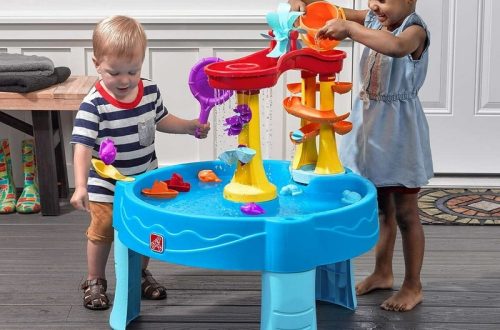Top Picks for Wooden Play Kitchens in 2023
Selecting the perfect wooden play kitchen can be a delightful endeavor in 2023. With so many styles and brands to choose from, here are some of the top picks that have captured the hearts of parents and kids alike.
Classic Chef’s Wooden Play Kitchen:
This timeless design features a natural wood finish with interactive elements like clickable knobs and a chalkboard for menus. Ideal for kids who love a touch of tradition in their play.
Modern Deluxe Wooden Play Kitchen:
For those who prefer a sleek, contemporary look, this option comes equipped with stainless-steel-like fixtures and a cutting-edge design that mimics real modern kitchens.
Compact Corner Wooden Play Kitchen:
Perfect for smaller spaces, this kitchen fits snugly into corners and offers abundant features including a fridge, oven, and microwave—all in one convenient station.
Rustic Farmhouse Wooden Play Kitchen:
This one brings a country vibe into playtime with a rustic design, complete with a farmhouse sink and vintage details that encourage imaginative rural-inspired adventures.
Interactive Island Wooden Play Kitchen:
Complete with a central island, this kitchen encourages social play and teamwork, featuring amenities such as a built-in ice maker and interactive stovetop.
When scouting for the best wooden play kitchens, make sure to consider durability, design, and the kind of creative play it encourages. Always aim for a product that will stand the test of time, both in construction and in timeless enjoyment for your kids.

The Benefits of Wooden Play Kitchens for Child Development
Wooden play kitchens offer more than just fun. They are tools for growth and learning. As kids engage in pretend play, they develop various skills. Here’s how wooden play kitchens benefit child development:
Stimulate Creativity and Imagination:
Encouraging kids to create menus, cook meals, and run a busy kitchen fuels their imaginations.
Enhance Motor Skills:
Twisting knobs, opening doors, and sorting play food items help improve fine motor skill development.
Promote Social Interaction:
Sharing the kitchen space with siblings or friends helps build communication and social skills.
Teach Life Skills:
Wooden kitchens allow children to mimic adults, cooking and organizing, which are vital life management skills.
Encourage Problem-Solving:
Deciding how to fix a ‘broken’ appliance or cook a ‘meal’ needs problem-solving abilities.
Wooden kitchen playsets hold up well over time. They resist damage and wear, which is a bonus for growing families. Choosing a wooden play kitchen can support your child’s development in a playful, nurturing environment. It’s an investment in their creative potential and education. Always pick one that fits your child’s needs and your home space for the best experience.
Design Features to Consider When Choosing a Wooden Play Kitchen
When you’re in the market for a wooden play kitchen, design features are key. They directly influence how your child interacts with the kitchen and how it fits into your home. Here are essential design features to consider:
- Size and Layout: Ensure the kitchen is the right size for your child and your space. A good fit promotes accessibility and comfort during play.
- Storage Capacity: Look for kitchens with shelves, cabinets, or hooks. Ample storage means more play items can be organized and stowed away, keeping your space tidy.
- Realistic Details: Features like turnable knobs, opening oven doors, and a clickable timer add to the realism. These details inspire deeper imaginative play.
- Eco-Friendly Materials: Choose play kitchens made with non-toxic, sustainable wood for a safer play environment and a healthier planet.
- Adjustability: Some wooden play kitchens come with adjustable heights. This means the playset can grow with your child, ensuring years of use.
- Color and Finish: Pick a kitchen with a color and finish that complements your home decor. It should be inviting for kids yet not clash with your living space.
- Work Surface Area: A spacious countertop gives kids plenty of room to ‘prepare food’ and collaborate with friends, enhancing their social and motor skills.
- Compatibility with Accessories: Make sure the play kitchen can accommodate various play food items and cooking utensils. More comprehensive compatibility means more possibilities for creative play.
Selecting the right design features will not only spark your child’s imagination but will also ensure the wooden play kitchen remains a beloved and functional toy in your home for years to come. Incorporate these considerations into your decision-making to find a kitchen that best suits your child’s developmental needs and your living space.

Wooden vs. Plastic Play Kitchens: Which Is Better for Your Child?
Choosing the right material for your child’s play kitchen is crucial. Wooden and plastic play kitchens both offer different benefits. Here’s a comparison to help make your choice easier:
- Durability: Wooden play kitchens often outlast their plastic counterparts. They can withstand rough play and last for years.
- Safety: Wood is a natural and sturdy material less likely to break. Plastic kitchens may crack and create sharp edges.
- Environmental Impact: Wooden kitchens are eco-friendlier. They are often made from sustainable sources, and wood is biodegradable.
- Aesthetics: Many parents find wooden play kitchens more visually appealing. They blend well with home decor, unlike some plastic models.
- Developmental Value: The solid feel of wood can enhance a child’s sensory experience. It encourages more realistic play scenarios.
- Cost: Plastic kitchens might be less expensive upfront. But wooden kitchens can offer more value over time due to their durability.
- Maintenance: Cleaning wooden kitchens may demand more care. Plastic is easier to wipe down but may not withstand persistent cleaning.
Overall, wooden play kitchens are often a better choice for long-term quality and sustainability. They promote a more authentic and enriching play experience for children. Yet, if budget and easy maintenance are your main concerns, plastic may be the way to go. Always consider your child’s needs and your family values when choosing.
Safety Tips for Wooden Play Kitchens
Ensuring the safety of children while they play is paramount. When selecting and setting up a wooden play kitchen, keep these safety tips in mind:
- Check for Certification: Look for safety certifications. These verify that the kitchen meets certain standards.
- Stable Construction: A sturdy kitchen won’t tip over easily. Make sure it’s assembled correctly and anchored if necessary.
- Smooth Edges and Corners: Choose kitchens with smooth, rounded edges. This reduces the risk of injury from sharp corners.
- Non-toxic Materials: Use play kitchens made with non-toxic paint and finishes. They should be safe for kids if they put toys in their mouths.
- Regular Inspections: Inspect the kitchen periodically for any loose screws or worn parts that might need fixing.
- Age-Appropriate Design: Pick a kitchen that’s designed for your child’s age group. Younger kids need simpler features to avoid frustration or injury.
- Supervision: Keep an eye on children, especially younger ones, during play. Active supervision prevents accidents.
- Safe Accessories: Ensure play items are large enough not to be choking hazards. They should also be made of safe materials.
Through these precautions, you can create a fun and secure environment for your little ones to explore their culinary creativity.
Creative Ways to Enhance Playtime with Wooden Kitchens
Enriching playtime activities with a wooden play kitchen can open up a world of learning and enjoyment for children. Here are some creative ways to boost their play experience:
- Introduce Themed Play Days: Set up different themes for playtime, like ‘Bakery Day’ or ‘International Cuisine Day’. Kids can learn about various foods and cultures while playing.
- Encourage Role Play: Suggest roles like head chef, waiter, or customer. Role-playing can teach kids about teamwork and responsibility.
- Play Food Crafting: Let kids craft their play food out of clay or paper. It sparks creativity and adds a personal touch to their kitchen.
- Incorporate Learning: Introduce simple math by having them ‘buy and sell’ food items. It can help with their counting and money handling skills.
- Recipe Creation: Have them create their own recipes and menus. This activity builds literacy skills and allows for imaginative expression.

- Gardening Session: Include a small herb garden they can tend and use in cooking. It teaches them about nature and healthy eating habits.
- Cooking Shows and Competitions: Host a pretend cooking show or competition. It can be a fun way to build confidence and presentation skills.
- Include Realistic Accessories: Equip the kitchen with items that look and feel real. It makes play more engaging and realistic.
- Set Up a Market Area: Create a play area where they can shop for ingredients. It broadens the scope of play and social interaction.
By integrating these creative methods into playtime with wooden play kitchens, children can enjoy a more diverse and educational experience. Plus, these activities keep their interest piqued and enhance the value of their pretend play.
Maintenance and Cleaning Tips for Long-lasting Wooden Play Kitchens
Maintaining a wooden play kitchen is key to its longevity. Here’s how to keep it in top shape:
- Wipe Spills Immediately: Clean spills quickly to prevent stains and wood damage. Use a damp cloth.
- Avoid Harsh Chemicals: Stick to mild soap and water for cleaning. Harsh cleaners can harm the finish.
- Regular Dusting: Dust the kitchen often to maintain its look and functionality. A soft cloth works best.
- Check for Loose Parts: Tighten any screws or knobs that come loose over time. This keeps the kitchen safe.
- Refresh the Finish: Apply a non-toxic finish if the kitchen looks worn. It can make it look new.
- Protect from Sunlight: Keep the kitchen away from direct sunlight. Sun can cause color fading.
- Deep Clean Periodically: Do a thorough clean monthly. Focus on crevices and corners where dirt accumulates.
- Use Gentle Tools: Soft brushes can reach tight spaces. They won’t scratch the wood.
- Educate Your Child: Teach your child how to care for their kitchen. It encourages responsibility.
By following these simple maintenance and cleaning tips, your child’s wooden play kitchen can provide joy for years to come. Good care means lasting fun and fewer replacements. It’s worth taking the time to maintain this imaginative play space.
Where to Buy Quality Wooden Play Kitchens for Kids
Finding the perfect wooden play kitchen for your child is the last step. There are a number of places where you can find high-quality play kitchens that will inspire your little chef. To help you on your quest, consider these options:
- Local Toy Stores: Start with nearby toy stores. They often carry quality wooden toys, including kitchens.
- Online Retailers: Websites like Amazon, Etsy, or dedicated children’s furniture sites have a wide range. They provide customer reviews, which can guide you.
- Specialty Children’s Stores: These stores focus on educational and wooden toys. Staff can give personalized recommendations.
- Furniture Stores: Some furniture retailers carry children’s items, such as wooden play kitchens.
- Second-hand Shops: Look for gently used kitchens. They can be as good as new but at a lower cost.
- Craft Fairs or Local Makers: Unique, handcrafted kitchens are available here. They are often customizable.
- Direct from Manufacturers: Buying direct can sometimes save money. Check if your favorite brands sell online.
Choose a seller that provides detailed product info and good customer service. Check return policies and warranties too. By selecting from reputable sources, you ensure a safe and durable wooden play kitchen for your kids.



